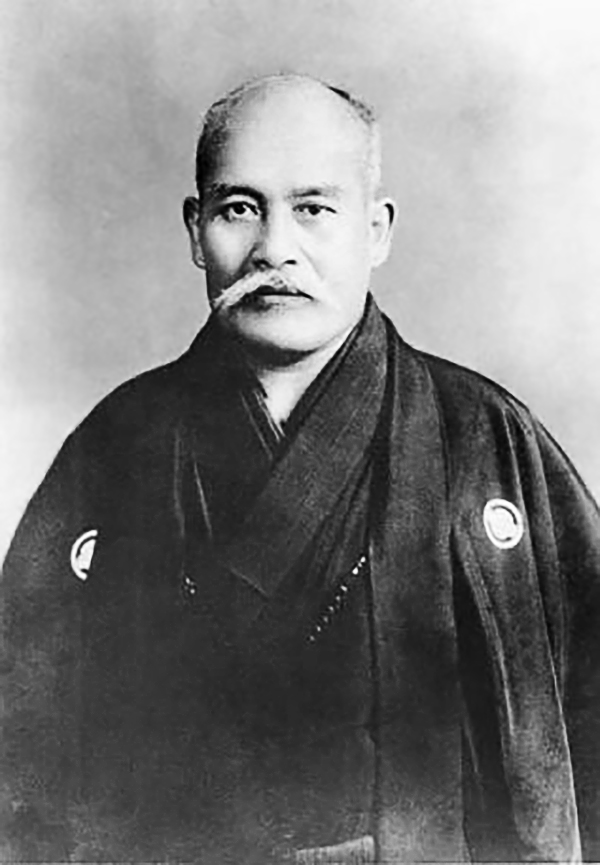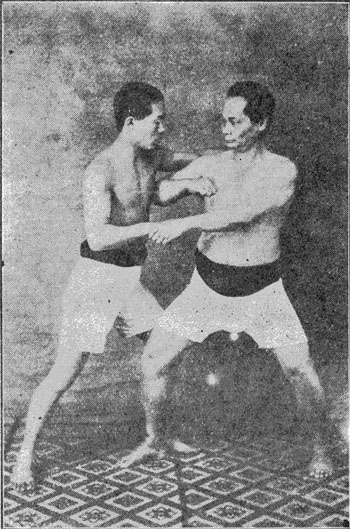|
Randori
is a term used in Japanese martial arts to describe free-style practice (sparring). The term denotes an exercise in 取り ''tori'', applying technique to a random ( 乱 ''ran'') succession of ''uke'' attacks. The actual connotation of ''randori'' depends on the martial art it is used in. In judo, jujutsu, and Shodokan aikido, among others, it most often refers to one-on-one sparring where partners attempt to resist and counter each other's techniques. In other styles of aikido, in particular Aikikai, it refers to a form of practice in which a designated aikidoka defends against multiple attackers in quick succession without knowing how they will attack or in what order. In Japan The term is used in aikido, judo, and Brazilian jiu-jitsu dojos outside Japan. In Japan, this form of practice is called , which literally means multiple attackers. In judo The term was described by Jigoro Kano, the founder of judo, in a speech at the 1932 Los Angeles Olympic Games: "Randori, mean ... [...More Info...] [...Related Items...] OR: [Wikipedia] [Google] [Baidu] |
Judo
is an unarmed gendai budō, modern Japanese martial art, combat sport, Olympic sport (since 1964), and the most prominent form of jacket wrestling competed internationally.『日本大百科全書』電子版【柔道】(CD-ROM version of Encyclopedia Nipponica, "Judo"). Judo was created in 1882 by Kanō Jigorō () as an eclectic martial art, distinguishing itself from its predecessors (primarily Tenjin Shin'yō-ryū, Tenjin Shinyo-ryu jujutsu and Kitō-ryū jujutsu) due to an emphasis on "randori" (, lit. 'free sparring') instead of alongside its removal of striking and weapon training elements. Judo rose to prominence for its dominance over Kodokan–Totsuka rivalry, established jujutsu schools in tournaments hosted by the Tokyo Metropolitan Police Department (警視庁武術大会, ''Keishicho Bujutsu Taikai''), resulting in its adoption as the department's primary martial art. A judo practitioner is called a , and the judo uniform is called . The objective of competitive ju ... [...More Info...] [...Related Items...] OR: [Wikipedia] [Google] [Baidu] |
Randori-no-kata
The of Kodokan Judo consist of two kata that illustrate the principles behind techniques used in , allowing them to be practiced with maximum efficiency. The ''randori-no-kata'' includes , which teach and demonstrate concepts of and , which are intended to teach concepts of . The ''randori-no-kata'' were developed by Jigoro Kano as a teaching aid when it became apparent that he had too many students to effectively demonstrate throws and grappling techniques in his classes. The kata were developed in five years that followed the establishment of the Kodokan The , or ''Kōdōkan'' (講道館), is the headquarters of the worldwide judo community. The ''kōdōkan'' was founded in 1882 by Kanō Jigorō, the founder of judo, and is now an eight-story building in Tokyo. Etymology Literally, ''kō'' ..., between 1882 and 1887. They originally consisted of ten techniques each and were expanded to fifteen techniques around 1906. References * Jigoro Kano, ''Kodokan Judo'', K ... [...More Info...] [...Related Items...] OR: [Wikipedia] [Google] [Baidu] |
Aikido
Aikido ( , , , ) is a gendai budō, modern Japanese martial art which is split into many different styles including Iwama Ryu, Iwama Shin Shin Aiki Shuren Kai, Shodokan Aikido, Yoshinkan, Renshinkai, Aikikai, and Ki Aikido. Aikido is now practiced in around 140 countries. It was originally developed by Morihei Ueshiba, as a synthesis of his martial studies, philosophy and religious beliefs. Ueshiba's goal was to create an art which practitioners could use to defend themselves against attacks, while also protecting the attackers from injury. Aikido is often translated as "the way of unifying (with) Qi, life energy" or as "the way of harmonious spirit". According to the founder's philosophy, the primary goal in the practice of aikido is to overcome oneself instead of cultivating violence or aggressiveness. Morihei Ueshiba used the phrase to refer to this principle. Aikido's fundamental principles include: (entering), , (breathing control), (triangular principle), and (turn ... [...More Info...] [...Related Items...] OR: [Wikipedia] [Google] [Baidu] |
Jujutsu
Jujutsu ( , or ), also known as jiu-jitsu and ju-jitsu (both ), is a Japanese martial art and a system of close combat that can be used in a defensive or offensive manner to kill or subdue one or more weaponless or armed and armored opponents. A subset of techniques from certain styles of jujutsu were used to develop many modern martial arts and combat sports, such as judo, aikido, sambo, Brazilian jiu-jitsu, ARB, and mixed martial arts. Characteristics " Jū" can be translated as "gentle, soft, supple, flexible, pliable, or yielding", and " jutsu" can be translated as "art or technique". "Jujutsu" thus has the meaning of "yielding-art", as its core philosophy is to manipulate the opponent's force against themself rather than confronting it with one's own force. Jujutsu developed to combat the samurai of feudal Japan as a method for defeating an armed and armored opponent in which one uses no form of weapon, or only a short weapon. Because striking against an armored ... [...More Info...] [...Related Items...] OR: [Wikipedia] [Google] [Baidu] |
Japanese Martial Arts
Japanese martial arts refers to the variety of martial arts native to the country of Japan. At least three Japanese terms (''budō'', ''bujutsu'', and ''bugei'') are used interchangeably with the English phrase Japanese martial arts. The usage of the term ''budō'' (武道) to mean martial arts is a modern one: historically the term meant a way of life encompassing physical, spiritual and moral dimensions with a focus on self-improvement, fulfillment or personal growth. The terms ''bujutsu'' (武術) and ''bugei'' (武芸) have different meanings from ''budō'', at least historically speaking. ''Bujutsu'' refers specifically to the practical application of martial tactics and techniques in actual combat. ''Bugei'' refers to the adaptation or refinement of those tactics and techniques to facilitate systematic instruction and dissemination within a formal learning environment. History Each child who grew up in a samurai family was expected to be a warrior when he gre ... [...More Info...] [...Related Items...] OR: [Wikipedia] [Google] [Baidu] |
Kata
''Kata'' is a Japanese word ( 型 or 形) meaning "form". It refers to a detailed choreographed pattern of martial arts movements. It can also be reviewed within groups and in unison when training. It is practiced in Japanese martial arts as a way to memorize and perfect the movements being executed. Korean martial arts with Japanese influence ( hapkido, Tang Soo Do) use the derived term '' hyeong'' (hanja: 形) and also the term ''pumsae'' (hanja: 品勢 hangeul: 품새). Kata are also used in many traditional Japanese arts such as theatre forms like kabuki and schools of tea ceremony ('' chadō''), but are most commonly known in the martial arts. Kata are used by most Japanese and Okinawan martial arts, such as iaido, judo, kendo, kenpo, and karate. Background Kata originally were teaching and training methods by which successful combat techniques were preserved and passed on. Practicing kata allowed a company of persons to engage in a struggle using a syste ... [...More Info...] [...Related Items...] OR: [Wikipedia] [Google] [Baidu] |
Japanese Martial Arts Terminology
Japanese may refer to: * Something from or related to Japan, an island country in East Asia * Japanese language, spoken mainly in Japan * Japanese people, the ethnic group that identifies with Japan through ancestry or culture ** Japanese diaspora, Japanese emigrants and their descendants around the world * Japanese citizens, nationals of Japan under Japanese nationality law ** Foreign-born Japanese, naturalized citizens of Japan * Japanese writing system, consisting of kanji and kana * Japanese cuisine, the food and food culture of Japan See also * List of Japanese people * * Japonica (other) * Japanese studies , sometimes known as Japanology in Europe, is a sub-field of area studies or East Asian studies involved in social sciences and humanities research on Japan. It incorporates fields such as the study of Japanese language, history, culture, litera ... {{disambiguation Language and nationality disambiguation pages ... [...More Info...] [...Related Items...] OR: [Wikipedia] [Google] [Baidu] |
YouTube
YouTube is an American social media and online video sharing platform owned by Google. YouTube was founded on February 14, 2005, by Steve Chen, Chad Hurley, and Jawed Karim who were three former employees of PayPal. Headquartered in San Bruno, California, it is the second-most-visited website in the world, after Google Search. In January 2024, YouTube had more than 2.7billion monthly active users, who collectively watched more than one billion hours of videos every day. , videos were being uploaded to the platform at a rate of more than 500 hours of content per minute, and , there were approximately 14.8billion videos in total. On November 13, 2006, YouTube was purchased by Google for $1.65 billion (equivalent to $ billion in ). Google expanded YouTube's business model of generating revenue from advertisements alone, to offering paid content such as movies and exclusive content produced by and for YouTube. It also offers YouTube Premium, a paid subs ... [...More Info...] [...Related Items...] OR: [Wikipedia] [Google] [Baidu] |
Sparring
Sparring is a form of training common to many combat sports. It can encompass a range of activities and techniques such as punching, kicking, grappling, throwing, wrestling or submission work dependent on style. Although the precise form varies, it is essentially relatively ' free-form' fighting, with enough rules, customs, or agreements to minimize injuries. By extension, argumentative debate is sometimes called sparring. Differences between styles The physical nature of sparring naturally varies with the nature of the skills it is intended to develop; sparring in a striking art such as Karate will normally begin with the players at opposite sides of the mat and will be given a point for striking the appropriate area and will be given a foul for striking an inappropriate area or stepping out of the area. Sparring in a grappling art such as judo might begin with the partners holding one another and end if they separate. The organization of sparring matches also varies; if the ... [...More Info...] [...Related Items...] OR: [Wikipedia] [Google] [Baidu] |
Kumite
Kumite (, literally "grappling hands") is one of the three main sections of karate training, along with kata and kihon. Kumite is the part of karate in which a person trains against an adversary. Kumite can be used to develop a particular technique or a skill (e.g. effectively judging and adjusting one's distance from one's opponent) or it can be done in competition. Types Since the word "kumite" refers to forms of sparring, it covers a vast range of activities. In traditional Shotokan karate, the first type of kumite for beginners is ''gohon kumite''. The defender steps back each time, blocking the attacks and performing a counterattack after the last block. This activity looks nothing like the ''jiyu kumite'' (or "free sparring") practiced by more advanced practitioners. Types: * ''Ippon kumite'' - one step sparring, typically used for self-defense drills * ''Sanbon kumite'' - three-step sparring, typically used to develop speed, strength, and technique * ''Gohon kumite'' ... [...More Info...] [...Related Items...] OR: [Wikipedia] [Google] [Baidu] |







